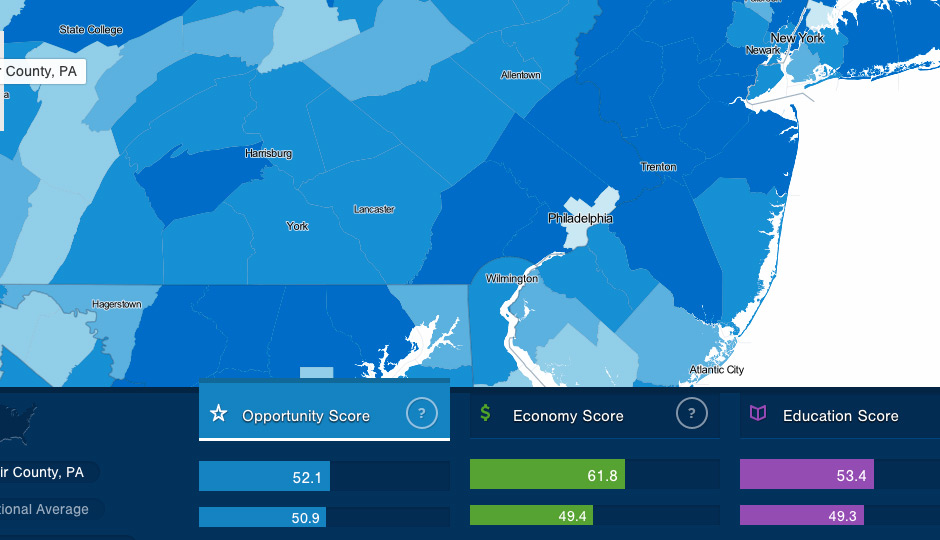“Opportunity Index” Ranks Philly, ’Burbs for Social Mobility
In the decades since the term was first coined – in the preface of a 1931 book by historian James Truslow Adams – the notion of an “American Dream” that binds all U.S. citizens to a common goal of individual empowerment has taken on near religious significance. Four years into a recovery from the worst recession in more than half a century, it seems many of us have lost our faith.
A poll last month by The Washington Post and the Miller Center at the University of Virginia found that while a majority of respondents say the American Dream still has personal meaning to them, fewer than half think they have a chance of achieving it. And they’re pretty sure their kids won’t either.
Most American parents now accept that their children can look forward to a standard of living equal to or less than that which they now enjoy.
But for those trying to bite and scratch their way out of the nation’s increasingly segregated socio-economic backwaters, the prospects are especially bleak; because, while America may be the land of opportunity, your chances of finding it are closely defined by where you call home.
Last week, Opportunity Nation – a nonpartisan coalition of more than 200 community empowerment organizations – released its third-annual “Opportunity Index,” which ranks areas by zip code based on 14 variables considered critical to social mobility. These range from access to the Internet and affordable housing to public safety and levels of volunteerism, and are sorted into three overarching categories: Jobs and the Economy; Education; and Community Health and Civic Life.
As might be expected, high-poverty rural and urban areas tend to be low in all three categories – which is both a function of, and a contributor to, social immobility.
As for Pennsylvania, we ranked near the middle of the 2013 Index, coming in 23rd out of 50 states. The commonwealth could have done a lot better if it didn’t have to carry Philly. Among the 25 most populous urban counties, Philadelphia ranked at or near the bottom in most categories, and is one of only three major metropolitan counties to score a D+. Here’s how the city stacked up compared to its neighboring counties and the state as a whole across three primary categories (the overall Opportunity Score is composite of all three).
It probably won’t surprise anyone that Philadelphia has the lowest median income and, at 25.1%, the highest poverty rate of the nation’s most populous urban counties. And we’re tied with Kings County (Brooklyn) for having the most income inequality. But among the more noteworthy takeaways from the report is that a family’s income level – while a significant factor in a child’s future success – is not the biggest determinant of social mobility.
Education plays a bigger role. Philadelphia has the lowest on-time high school graduation rate of major metropolitan areas, with one in two students taking longer than four years to graduate from high school. But it’s what kids do after they graduate that has the greatest potential to set the course for the rest of their lives. By 2018 it’s projected that nearly two-thirds of job openings will require some post-secondary education, and the largest jobs growth will be in fields that require at least an Associate degree. Only about a quarter of students from Philadelphia’s “neighborhood schools” — which include public high schools servicing some of the city’s poorest areas — make it to college within six years of graduation.
Yet it’s not just about college. It’s about doing something, anything, to stay engaged in the community after graduating high school. Opportunity Nation found the strongest correlation between levels of “disconnected” youth – which refers to teens and young adults who are neither in school, nor working – and an area’s overall opportunity score. Roughly 15 million American youths are currently in a state of virtual idleness. In Philadelphia one out of every five young adults between the ages of 16-24 is “disconnected” – and there is evidence that the longer you do nothing out of high school the less likely you are to succeed.
This lends support to my belief that in an economy with fewer and fewer jobs for unskilled laborers, newly minted graduates should be offered incentives to transition into a two-year national service commitment in lieu of attempting to enter the workforce if they choose not to go to college.
Granted, when it comes to opportunity there are a number of variables that are simply out of our control. Kids have no say in whether or not their parents graduated high school (a strong determinant of social mobility) and there are individual characteristics — like tenacity and charisma — that some of us have and some of us don’t. But there are a number of factors that do contribute to social mobility that can’t be ignored.
Earlier this year a team of researchers from Harvard and the University of California–Berkeley analyzed millions of earnings records in an attempt to gauge the inter-generational mobility of children born between 1980 and 1981, and found that kids from two-parent families who live in communities with average-to-good schools and a culture of civic engagement seem to fare the best. And social mobility tends to be higher in metropolitan areas where poor families are dispersed among mixed-income neighborhoods – evidence that gentrification, for all of its potential problems, may actually offer some benefits — by sprinkling water in the socio-economic desert, as it were.
The point seems to be that with the right resources, people can pull themselves up by their bootstraps. Let’s work on giving them boots instead of just helping them pull.



